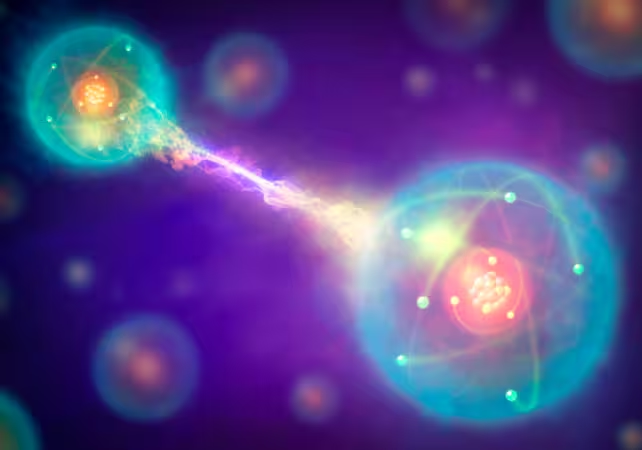5 Minutes
In an unexpected milestone for quantum communications, researchers in the United States have successfully teleported a quantum state of light through more than 30 kilometers of active fiber-optic cable carrying real internet traffic. The experiment demonstrates that delicate quantum signals can survive the noisy environment of existing telecommunications infrastructure — a critical step toward a practical quantum internet, stronger encryption schemes, and new sensing technologies.
How they made teleportation work on a busy network
Quantum teleportation sounds like science fiction: transfer the exact quantum state of a particle at one location to a different particle somewhere else, without moving the particle itself. In practice, teleportation copies the probabilistic quantum state from one photon to another by entangling two particles and performing coordinated measurements. Those measurements collapse the original state and, with the right classical information, recreate it at the receiving end.
But sending a lone quantum photon down fiber already saturated with classical data is fiendishly hard. Thermal motion, stray electromagnetic waves and scattering all conspire to destroy the fragile quantum information in a process called decoherence. The team overcame these challenges while the fiber carried roughly 400 gigabits per second of internet traffic — bank transactions, streaming video and text moving alongside the quantum channel.

Optical fibers are used to transmit internet communication. (alphaspirit it/Canva)
Rather than laying dedicated quantum lines, the researchers tuned the quantum channel to wavelengths and timing slots that minimize scattering and cross-talk with the classical streams. By carefully characterizing how light scatters in the cable and placing the photons at a "judicial point" in the spectrum, they reduced the risk of the quantum signal mixing with ordinary internet traffic. The result: successful teleportation of the quantum state across more than 30 km of live fiber.
"This is incredibly exciting because nobody thought it was possible," said Prem Kumar, a computing engineer at Northwestern University who led the study. "Our work shows a path towards next-generation quantum and classical networks sharing a unified fiber optic infrastructure."
Why this matters: quantum internet without new highways
Previous lab demonstrations sent quantum signals alongside simulated classical data or used specialized fiber. Kumar's team is the first, to their knowledge, to teleport a quantum state while real internet traffic flowed through the same cable. That suggests we may not need to rebuild global networks to add quantum capability — we can coexist on the same physical infrastructure if wavelengths and protocols are chosen carefully.
Practical quantum links could unlock several advances:
- Secure quantum key distribution that resists future quantum-computer attacks.
- Distributed quantum computing, where geographically separated processors share entangled states.
- Enhanced sensing and metrology that use entanglement to surpass classical limits.
"Quantum teleportation has the ability to provide quantum connectivity securely between geographically distant nodes," Kumar added. “But many people assumed nobody would build specialized infrastructure to send particles of light. If we choose the wavelengths properly, we won't have to build new infrastructure. Classical communications and quantum communications can coexist.”

Technical snapshot: entanglement, photons and noise control
The experiment teleported the quantum state of a light field — effectively a single photon's state — rather than macroscopic objects. Entanglement established correlated quantum identities between sender and receiver. A joint measurement at the sender destroyed the original state and transmitted classical information enabling the receiver to reconstruct it on a paired photon.
Key to success were measures that limited where and when the quantum photons could interact with the classical traffic: smart wavelength selection, temporal gating, and precise control of scattering effects. Those engineering choices reduced decoherence long enough for teleportation to complete, despite a torrent of background data.
The team published their results in Optica, underscoring a replicable technique for integrating quantum channels into the current internet backbone. Watch the clip below for a summary of their research:
Implications and next steps for quantum networks
While this demonstration doesn't let you "beam" physical objects, it does show that the quantum state needed for secure links and distributed quantum tasks can travel alongside everyday internet traffic. Future work will scale distances, improve error rates, and integrate quantum repeaters that extend entanglement across longer spans. Engineers will also refine multiplexing methods so many quantum channels can share fibers without mutual interference.
Long-term, these advances could lead to hybrid classical–quantum networks where data, keys and quantum resources move together. That would accelerate real-world adoption of quantum-enhanced services without costly infrastructure replacement.
Expert Insight
"This experiment represents a pragmatic bridge between fundamental quantum physics and the messy reality of commercial networks," says Dr. Lena Ortiz, a quantum communications engineer (fictional) with experience in fiber-optic deployments. “By proving coexistence with high-rate classical traffic, the field can shift from isolated lab setups to pilot deployments over municipal and national backbones. The next challenge is robust error correction and operational protocols that work at scale.”
Source: sciencealert
Comments
Marius
Is this even ready for real networks? sounds promising but I'm skeptical, error rates, repeaters, latency, maintenance… the real world is messy
atomwave
wow didnt expect teleportation to survive busy internet fiber! this could flip comms if it scales, omg buzzing


Leave a Comment